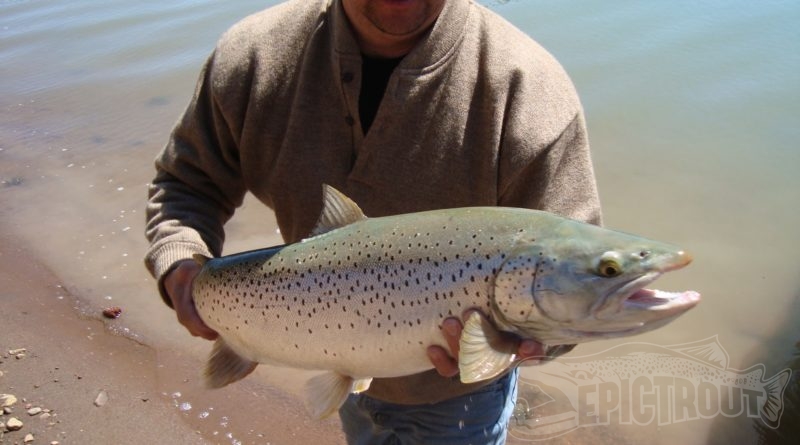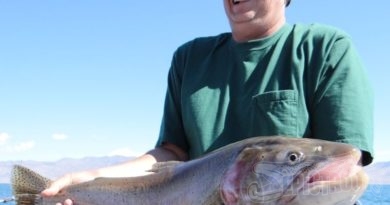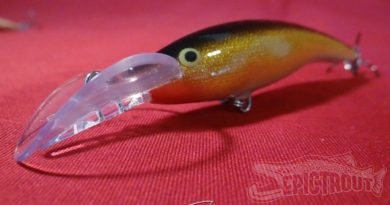Crayfish and Browns
Some guys won’t even go fishing if they can’t round up a couple of buddies to join in. While I have a few friends I like to fish with, I’m generally just as happy on a solo trip. My job involves a lot of social interaction and my house is always full of noise, so I truly enjoy time on the water alone, with nobody to bother me.
And no one to tell me what to do. No second guessing. No “Aren’t you trolling a little fast?” or “Aren’t you trolling a little slow?” I fish how I want to fish based on experience and the vibrations of the universe. And I catch more trout. I’ve caught most of my best fish alone, but this makes it tough to get good photos while still releasing my catch, and there’s definitely something to be said for sharing the moment with a good friend.
One guy I really I enjoy fishing with is my friend Brad Stout, and due to our busy schedules and living 70 miles apart, we don’t get together nearly enough. So when he called me this spring and asked me to join him for a camping and fishing trip outside Truckee, California, I quickly agreed. “Let’s commit now and just plan on going the weekend after next” he said. We talked about how it was too easy to say, yeah, I think so, let me get back to you, then a week, month or year goes by and you never go on the trip.
I enjoy fishing with Brad for several reasons. There’s the fact that if we’re camping, he brings his fifth-wheel trailer, which is like camping in a Holiday Inn. I also enjoy trolling in his 19 foot Alumaweld with Scotty electric downriggers and a big-screen color Lowrance sonar unit with GPS. Finally, Brad is an excellent cook and truly enjoys preparing and cooking gourmet meals in the field. So I pretty much just enjoy taking advantage of the poor sap and using him and his amenities for all they’re worth.
I kid. I would fish with this guy in a canoe in a snowstorm, and camp with him in a leaky pup-tent. Not only do Brad and I laugh our asses off and have way too much fun every time we hang out, but he is one of the very few people I fish with who is as obsessed with trophy trout and all that goes into catching them as I am. He’s also caught more big fish than me, but doesn’t rub it in my face.
Our fishing styles vary quite a bit when left to our own devices; when we last pulled off the springtime camping/fishing trip with another good buddy, I brought my little cartop boat and did better one morning slow-trolling cured anchovies than Brad and our mutual friend did from Brad’s big boat fast-trolling plugs. When together though, I usually defer to his ideas and act as first mate on the Alumaweld. I mean, the guy has just caught so freaking many big fish, I would be an idiot to second guess him.
So we showed up at the lake on Friday afternoon, set up camp, and started fishing in bright sun with a medium chop on the water. Brad had come up with a brilliant idea, that we could have a great dinner this first night, but that only canned food would await us if we didn’t catch our protein for Saturday night. Now we both understand the value of catch-and-release, but this lake has a very healthy population of brown trout and we also love fresh fish and reconnecting with our hunter-gatherer ancestors.

We trolled Custom painted Minnow plugs off the downriggers for several hours without a bite, but then Brad had a good takedown and despite a strong gust of wind that turned the boat and tangled our lines, we netted a 27 inch, 7.5 pound brown! We kept trying for another hour or two, then took a break. I filleted Brad’s catch, put the meat in his cooler, then we divided the head, guts, skin and bones between several crayfish traps that we set in shallow water near our campsite. We now had two ruby-red trout filets for Saturday night’s dinner, and were hoping to fill out the meal with some tasty crustaceans as well.

After setting the traps from Brad’s boat, we stayed on the water until dark, fishing from the downriggers and then topline trolling the shallows without another hit. Brad’s pork ribs (pre-smoked for 12 hours at his house then reheated at camp) and several side dishes filled my belly and ushered me off to a deep, blisfull and SHORT night’s sleep.
My cell phone alarm woke us well before dawn, and after a bathroom run and a hasty breakfast of energy bars, we launched his boat and were back at it. There was only a slight ripple on the water and nothing was biting on the downriggers, so after a couple of hours I tried putting a third line out off my sideplaner, first a shallow-running plug along the shoreline then a deep-diver off the other side of the boat. Nothing, nothing, nothing. We pulled back to shore around nine a.m. to stretch our legs, get a snack and compare notes with another friend who was fishing the lake in his boat. Tony had caught a couple of browns to four pounds, trolling a large Rapala in the shallows. Brad and I discussed changing techniques, but decided to stick with the downrigger approach that had caught a big brown the night before. So once again, we set our lures a couple of hundred feet back before clipping our lines into the downrigger releases. After another hour without any action, we began to wax philosophical when Brad said-
“You know, we should do this every year. We should just plan on it and do it. A spring fishing trip.”
“Definitely!” I replied. “You know, I’ve been thinking, I’m going to be 44 in July, and with these health problems I’ve been finding out about; I may have only 20 more years or so to do these kinds of trips.”
“Wiza, that’s depressing” replied Brad. “I’m 40 and I feel great.”
“No, what I mean is… life is short! And we need to enjoy these times now! And plan more of these times!”
“Whatever dude, you’re a buzz kill.” We were both laughing hard over the ridiculous direction of the conversation when Brad yelled “Look, downward pumps!”
We were employing one of Brad’s favorite downrigger techniques, which is to run the lure off a stacker release clip positioned up the cable just far enough that the lure runs a hair shallower than the ball. Then the boat is driven over depth changes so that the ball drags the bottom frequently in the shallower portions of the trolling run.
Not for the faint of heart or for those worried about the price of downrigger balls, this technique gives the lure extra action as it ‘follows the bouncing ball.’ It also means that you are constantly watching your rod tip jumping and dancing as well, and if you’re not used to this method you’ll find yourself yelling “Fish on!” every time you look at your rod.
The key here as Brad has taught me is that the pumps imparted to the rod by the downrigger ball dragging up an underwater slope are upward pumps, caused by the ball jumping and bumping into shallower water. Amidst this chaos, the angler watches for downward pumps which indicate a hooked fish pulling the rod tip down toward the downrigger clip.
And that’s just what we were seeing. According to Brad, a lot of people just don’t understand the whole ‘downward-versus-upward-pumps’ concept, so he decided he wanted to capture these particular downward pumps on video.
“Let me get a clip of this.” he said.
“Set the hook!” I replied. “That’s a good fish! Let’s film you fighting it!”
“Just let me get a little footage of the downward pumps.”
“If you don’t pop the clip and set the hook I will, and then it’s my fish!”
That convinced him. He put the camera down and grabbed the rod, sweeping it upward while reeling hard until the line popped out of the downrigger release. As to why a good fish had not already pulled the line free, let me just say that Brad believes in a heavy setting on the clip. Really heavy. So heavy it would take a 20 pound fish to pull the line free without help. Any lighter and the line releases too often on its own when employing this extreme downrigger technique.
As I cleared the other lines and downriggers, Brad first reported that the fish felt heavy, then that it was running rapidly toward the boat. I captured the action on video, and as a big brown surfaced 10 feet out, I concentrated on keeping it in frame, watching intently through the tiny LCD screen.
“That’s a big fish! Over ten!” Brad remarked, which I immediately disputed, telling him it was good brown, but only maybe seven pounds. Problem was, in my desire to capture all the action, I had seen Brad’s fish only through the weenie little viewfinder of the video camera, which as it turns out makes a brown trout over ten pounds look around seven.
Intent as I was on getting great footage of Brad netting the big brown, I nervously watched the beast thrashing wildly at the surface, desperately trying shake free from the lure. I also saw Brad’s arm outstretched to the maximum with the long-handled net extended as far as possible but still a good three feet away from the fish, and his other arm holding the rod as far back behind him as he could, tip high in the air, trying but unable to pull the big trout toward the net.
The Jesus On The Cross technique was not going to work, I realized, so I asked “You want me to net it?”
“Please!” croaked Brad desperately. I put down the camera and grabbed the net as Brad walked backward toward the bow of the boat, sliding the fish forward enough for me to scoop it up on the first try.
So we missed getting video of the fish being netted. We also had to edit out some other parts as apparently I swear like a drunken sailor when dealing with monster brown trout. We weighed and measured Brad’s catch, amazed at its obesity. At 28 inches it was only an inch longer than the brown he’d caught the previous night, but at 11.5 pounds it was an astounding four pounds heavier! That’s a heavy inch! Though very different in shape, both fish and shared a unique, silver-white coloration, similar to the brown trout’s sea-run cousin, the Atlantic salmon.
After some quick photos and additional video footage, Brad nosed his boat to shore, jumped out and revived his trophy catch by moving it back and forth in the water gently, flaring its gills until it shot out of his hands and darted away. Though this was Brad’s fifteenth brown trout over ten pounds, he hollered and jumped around like a little kid as we watched it go.
And I was right there in my second childhood with him. Sure, I would have liked to have caught such an amazing fish myself, but I netted it, filmed it, and shared the moment with a good friend. I also learned a few new tricks on this trip, as I do on any outing with Brad.
We went back to fishing and Brad graciously lent me his hot Lure that caught both his bigger fish, but of course it immediately stopped working for the rest of the trip. We pulled our crawdad traps in the late afternoon and were just astounded by the size of the freshwater crustaceans we found! We’re talking chicken lobsters here! That night we boiled them with a powdered crab-boil mix and enjoyed a cavemen-gourmet feast of fresh brown trout filets, salad, and crawdads so large that not only did we eat the tail meat, but also cracked the claws, finding inside them an even sweeter, softer meat, like lobster drenched in butter!
We fished again Sunday morning, with Brad catching two more small browns and having a big fish grab his lure at the surface while he held the line in his fingers, preparing to clip it into the downrigger release. He fought this one by hand for a couple of seconds before it threw up a huge splash and spit the hook, leaving us both wide eyed in a “Did that just happen?” moment. I couldn’t catch a fish to save my life, but I didn’t really care. I was there for my friend’s big fish, and we’d enjoyed fishing and camping like caveman kings for the weekend.
As we packed up to leave around noon, we agreed to make sure atraditional spring trip would happen again next year.
“Because you know, old man,” I told Brad, “we may only have 20 more good years for this sort of thing left in us.”
“Buzzkill.”
“And you should get that mole on your neck looked at, or maybe you’re not even gonna get the 20.”
“Really?”
“Yeah, it’s irregularly shaped; could be malignant.”
I drove away, laughing like a little kid as Brad worriedly examined his mole in his truck’s side-view mirror.
By Mark Wiza




